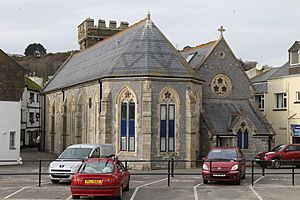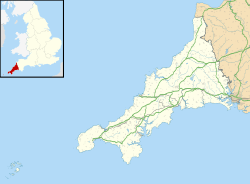St Mary's Church, East Looe facts for kids
Quick facts for kids St Mary’s Church, East Looe |
|
|---|---|

St Mary’s Church, East Looe
|
|
| 50°21′13.39″N 04°27′13.24″W / 50.3537194°N 4.4536778°W | |
| Location | Looe, Cornwall |
| Country | England |
| Previous denomination | Church of England |
| History | |
| Dedication | St Mary the Virgin |
| Dedicated | 1259 |
| Architecture | |
| Heritage designation | Grade II listed |
| Architect(s) | Edwin J Munt |
| Construction cost | £2,500 |
| Specifications | |
| Length | 90 feet (27 m) |
| Width | 30 feet (9.1 m) |
St Mary's Church is a historic building in Looe, Cornwall. It used to be a Church of England parish church. Today, it has been changed into homes.
Contents
History of St Mary's Church
Early Beginnings and Rebuilding
The first church on this spot was officially opened in 1259. This was done by Walter Branscombe, who was the Bishop of Exeter at the time. The church's tall tower was built later, in the 1400s.
Most of the church was rebuilt in 1806. This new building stood for many years. However, it was eventually replaced by an even newer church in 1882.
Building the New Church in 1882
In 1882, a group called the Incorporated Society helped fund the church's restoration. They gave £125 towards the work. The first stone for the new church was laid on August 14, 1882. Sir Alfred Sherlock Gooch, a well-known person, did the honors.
The new church was designed by Edwin James Munt, an architect from London. James Godfrey of Liskeard was chosen to build it. He agreed to do the work for £2,100. The old tower was kept because sailors used it as a landmark.
Design and Features of the 1883 Church
The new church was made 20 feet (about 6 meters) longer than the old one. It had a main area called a nave and a side area called a north aisle. The chancel, which is the part near the altar, was shaped like a pentagon. It had double windows on three of its sides.
Inside, the nave and aisle were separated by four arches. The pillars supporting these arches were made of Portland stone. They had shafts of Devonshire marble, which is a beautiful stone. The roofs were made from Baltic timber. The seats were crafted from Baltic wood and pitch pine. The floor was covered with special Godwin tiles. The church could hold 360 people. It was officially opened by the Bishop of Truro on August 20, 1883.
Later Additions and Changes
In 1892, a new reredos was added. A reredos is a decorated screen or wall behind the altar. It was designed by Edwin J Munt, the same architect who designed the church. It was built by Harry Hems and Sons. This reredos was a special memorial for Mrs. Bishop.
By the 1980s, the Church of England decided the church was no longer needed for regular services. In the 1990s, the Westcountry Housing Association took over the building. They turned it into sheltered accommodation, which means homes for people who need some support. A stonemason named Mark Robinson helped make the building stable. He also lowered some windows to let in more light on the ground floor.
Stained Glass Windows
St Mary's Church has several beautiful stained glass windows.
- By Ward and Hughes:
- Three windows at the east end remember James R Bishop, who died in 1881. They show scenes like the Annunciation (when an angel told Mary she would have a baby), the Presentation of Christ in the Temple, the Visit of the Magi (the wise men), the Flight into Egypt, and Christ in the Temple.
- Another window remembers Elizabeth Robins, who died in 1874. It shows Jesus as the Good Shepherd and Jesus blessing children.
- There is also a stained rose window, which is a round window with colored glass.
- By Fouracre of Stonehouse:
- One window shows the Baptism of John and the temptation of Christ in the Wilderness.
- Another window remembers Patience Medland, who died in 1882. It shows Jesus calling the fishermen to follow him and healing sick people.
Organ
A new pipe organ was put into the church in 1892. It was made by C Martin of Oxford. The organ was later rebuilt in 1913. You can find more details about this organ on the National Pipe Organ Register.


